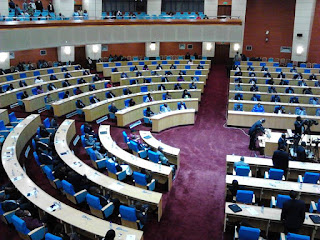The very long tradition of having President taking seat on the Chair of Speaker of the National Assembly when opening the new Session and Budget Meetings will soon come to an end if the new amendment proposal by Legal Affairs Committee of Parliament is adopted by the House.
Process of enhancing procedures of calling President to respond to members questions and question times for President after delivering the State of National Address in the House has necessitated the Presidents sitting changes.
Proposed amendment by the Committee will require President take seat on a newly allocated place while speaker still maintains his Chair so that he remains in control of the House.
Current practice, Presidents take seat on the Chair of the Speaker and remain seated until finishing delivering the State of National Address and leaves the House while the Speaker seats on a new allocated place.
“You know that there is the need for President to be coming to Parliament to answer questions, and if we could not think about where he will be sitting, there would have been some complications whereby members of Parliament will fail to engage with the President.” Explains hon. Peter Chakhwantha, Chairperson for the Committee
“Because, once the Speaker leaves that chair, that means whoever sit on that, takes control of the House and if the President continues to sit on that seat, that means he will be the one deciding the game.” He said
“So, we felt that the President should have his own seat and the Speaker should maintain that seat so that he is in charge of the House.”
This new arrangement further means that the Speaker will during question time remain in control of taking questions on behalf of president for him to respond, taking point of orders and supplementary questions and make usual guidance of the House.
“So, if we were to leave matters as they are that means it would have been the President choosing who should ask him, and who should get answer from. So, we have done it in a way that President should come to Parliament but will have a reserved seat, while the Speaker, being the head of Parliament will still being in control of affairs.” Added Chakhwantha
President Treatment When In Parliament
When President enters the Chamber, takes the Seat of the Speaker and signal the House to take seat by saying “Pray Be Seated” and takes the Chair
After delivering the State of the National Address, Speaker seating at some reserved place, rises and makes some announcements after which he says “It is now His Excellency the President’s pleasure to take his leave (of the House)” and adjourns the House to the next sitting day.
Before President enters the Chamber, the House firstly convenes for short period of time which the Speaker after announces Business of the Day’s Sitting suspends proceedings until President takes his Chair in the Chamber.






No comments:
Post a Comment